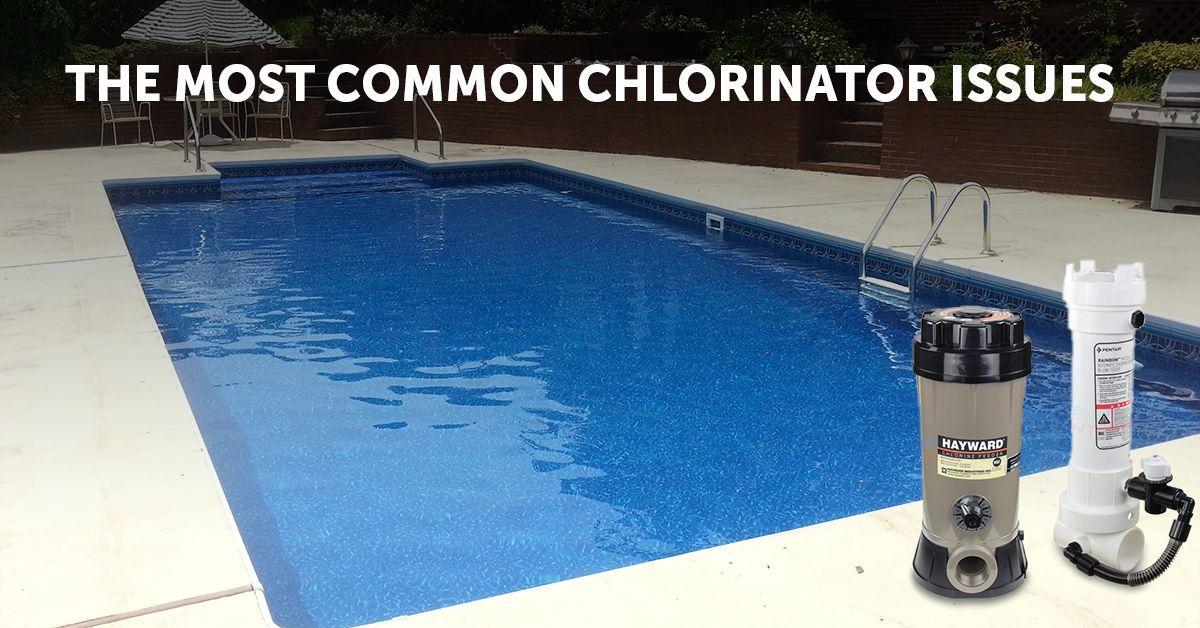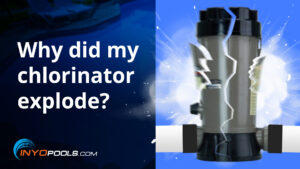Compared to other equipment, pool chlorinators are very straightforward to manage. Still, there are a few things that can go wrong during the installation and operation of your pool chlorinator.
In this article, we have compiled the most common swimming pool chlorinator issues and provide solutions that should help resolve the problem.
The Most Common Swimming Pool Chlorinator Issues
Before we begin, let’s make sure you know which type of chlorinator you have. There are two different types of chlorinators: inline and offline. The main difference between the two types of chlorinators is how you install it.
Offline chlorinators are ideal for pool owners installing a chlorinator into an existing pool line. You install them “off” of the existing plumbing line and attach thin tubes into the line.
On the other hand, you install inline chlorinators in line with your other pool equipment. This is a more permanent installation option and removes the need for additional tubing. There are no true benefits of installing one over the other. Truthfully, it depends on your current pool setup and what you have space for.
Tablets Are Not Dissolving
 One of the most common swimming pool chlorinator issues we encounter is the tablets not dissolving. Or, in some cases, they aren’t dissolving as quickly as you think they should.
One of the most common swimming pool chlorinator issues we encounter is the tablets not dissolving. Or, in some cases, they aren’t dissolving as quickly as you think they should.
However, pool owners can still come across other issues that contribute to undissolved chlorine tablets.
Solutions
Did you install your chlorinator correctly?
If your chlorinator has been working for some time now, you can probably exclude installation errors as the culprit. However, if it is a recent installation, we recommend beginning your search here. Offline chlorinators, especially, are prone to installation errors.
The direction of the hoses is especially important. Chlorinated water leaves the canister in a hose that connects to the main return line after the filter. However, if you reverse the hoses, the injection process that dissolves the chlorine will not function.
Look for directional arrows on the hoses showing the correct installation direction.
Did you set your output dial to 100%?
The output dial on the chlorinator controls the amount of chlorine you introduce to the passing water. Depending on the model, the dial setting ranges from 1 to 10. To increase the amount of chlorine that enters your pool, make sure you set the dial to 10, or the maximum.
Do you have a clogged control valve?
Sometimes, you might forget to close the control valve before you vacuum your pool. However, when this happens, there’s a chance that the passing debris can lodge itself inside of the valve. This reduces the flow going through the chlorinator and can cause your chlorine levels to drop.
To clear the valve, first, remove the chlorinator lid. Using tongs, remove the chlorine tablets from the canister. Next, using tongs, remove any sludge or debris at the bottom of the chlorinator. Finally, remove the screen and hose it down with water.
However, if this does not solve your problem, you may need to replace the control valve.
My Chlorinator Lid is Tight, Leaking, or Won’t Fit Properly
Whenever you have a leak, the first places you want to check are the gaskets and O-rings. The O-ring on the inside of the chlorinator can become brittle over time.
Solutions
If your chlorinator is leaking or you’re having difficulty closing the lid, we recommend replacing your O-ring. While the lid is off, we recommend checking for calcium deposits. Over time, small calcium deposits can form. If so, you can remove the deposits with a small screwdriver.
Also, it’s always good practice to lubricate your O-ring. This is an easy preventative step you can add to your maintenance routine to prevent future leaks. Lastly, if you have a crack in the lid, replace it. You can find replacement parts for your chlorinator by identifying the make and model.
Airlocks
Air can enter your system from anywhere in the pool line and ultimately end up in your chlorinator. An airlock inside your chlorinator can reduce both water flow and chlorination.
Solutions
You can actually check your chlorinator for an airlock yourself. First, turn your pump off and remove the chlorinator lid. Low water in the canister indicates the presence of air. Next, restart the pump while the lid is off and allow water to fill the canister. As the water rises, it will push the air out of the system.
Once the water fills the chlorinator, you can reinstall your lid.
Your Issue Not Covered?
Although these are the most common swimming pool chlorinator issues we encounter, we certainly believe there are more out there. If you are experiencing an issue with your chlorinator that we haven’t discussed, please send us an email or leave a post in the comment section.









Leave a Reply